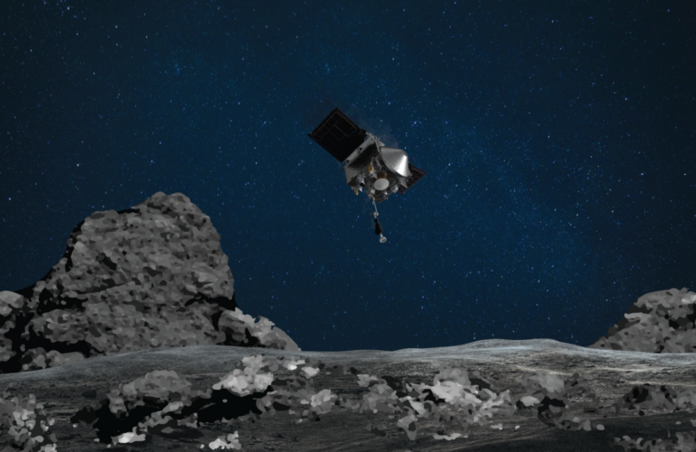NASA’s OSIRIS-REx spacecraft collects Bennu-sian dust!

On Oct. 20, 2020 at 11:10 pm British time, NASA’s Origins, Spectral Interpretation, Resource Identification, Security, Regolith Explorer (OSIRIS-REx) spacecraft “landed” on asteroid Bennu. Why is this exciting? Read on to find out – trust me it’s worth it!
You might know that asteroids can give us clues about the formation of the Solar System, in particular about our Earth and how life developed on it. Now that technology enables us to do so, getting material directly from these objects is the best way to perform experiments on asteroid dust and rocks in order to acquire that kind of information about our Solar System.
The first-ever landing on an asteroid was also conducted by NASA, on the 13th of February 2001 on Eros, however, this mission didn’t involve obtaining any samples. Then, the Japan Aerospace Exploration Agency JAXA’s Hayabusa missions in 2015 and 2019 enabled an initial two retrievals of asteroid material. Now it’s NASA’s turn to collect samples from an asteroid to try to understand the early Solar System better. The aim is to obtain about 60g of dust and pebbles in order to continue the studies made with the Hayabusa samples, in particular estimating the age of the Bennu compared to that of 25143 Itokawa and Ryugu, Hayabusa 1 and 2’s respective targets. If everything goes as planned, the pieces of Bennu will reach us in 2023.
This means that this is a long-term mission, in collaboration with JAXA: OSIRIS-REx launched from Cape Canaveral Air Force Station in Florida on the 8th of September 2016 and arrived at the asteroid in December 2018. Since then it has performed various tasks at a distance from Bennu as well as two collection rehearsals, now the exciting news is that the Touch-And-Go Sample Acquisition Mechanism (TAGSAM) successfully collected material from the asteroid.

Credits: NASA/Goddard/University of Arizona
The way this works is that the probe approaches the asteroid and once the TAGSAM touches the surface, a burst of gas gets released, lifting up dust and small pebbles which are sucked up by the sampler head. After 5 seconds a back-away manoeuvre is initiated so that OSIRIS-REx doesn’t crash into the asteroid. Further analysis needs to be conducted to know how much material was exactly retrieved, however, the probe could conduct another 2 of these sample collection “landings” before starting its journey back to Earth in 2021. What will be delivered back to Earth will be shared with JAXA like Hayabusa’s samples, as well as with other research groups, and some material will be preserved for future generations’ research.

Credits: NASA/Goddard/University of Arizona Full story
The OSIRIS-REx mission can lead to another type of concrete results – by studying Bennu’s properties we could better understand its trajectory and whether it will collide with Earth in the 2170s; for now, the probability of impact is estimated at 1 in 1410 (or 0.071%), so don’t panic!
If you want to try to observe Bennu, you can find information about its position and visibility here : https://theskylive.com/bennu-tracker
